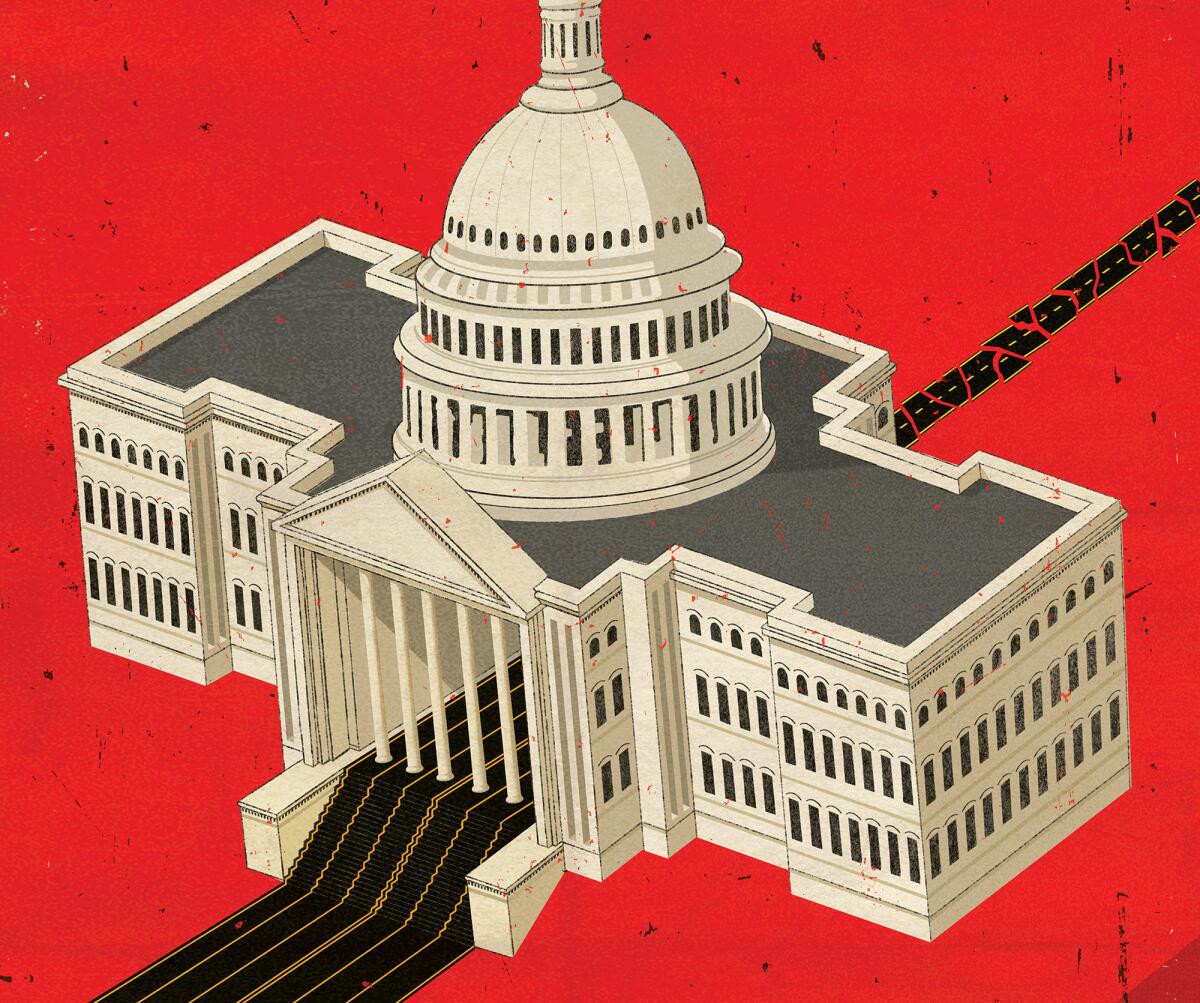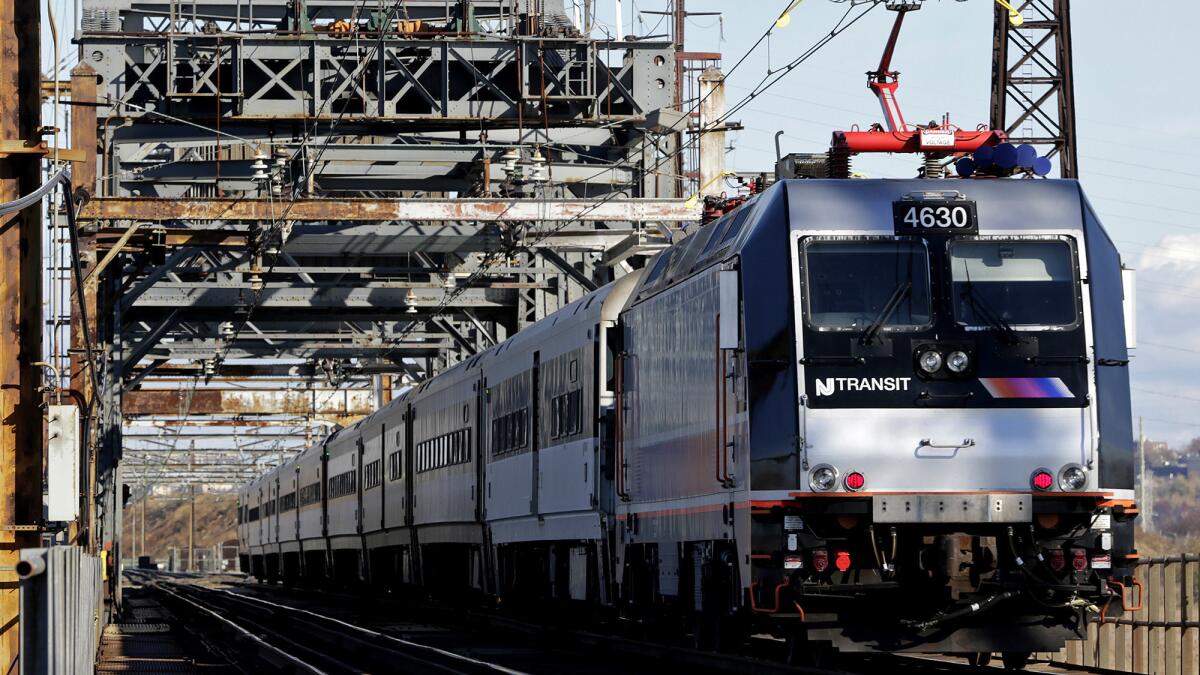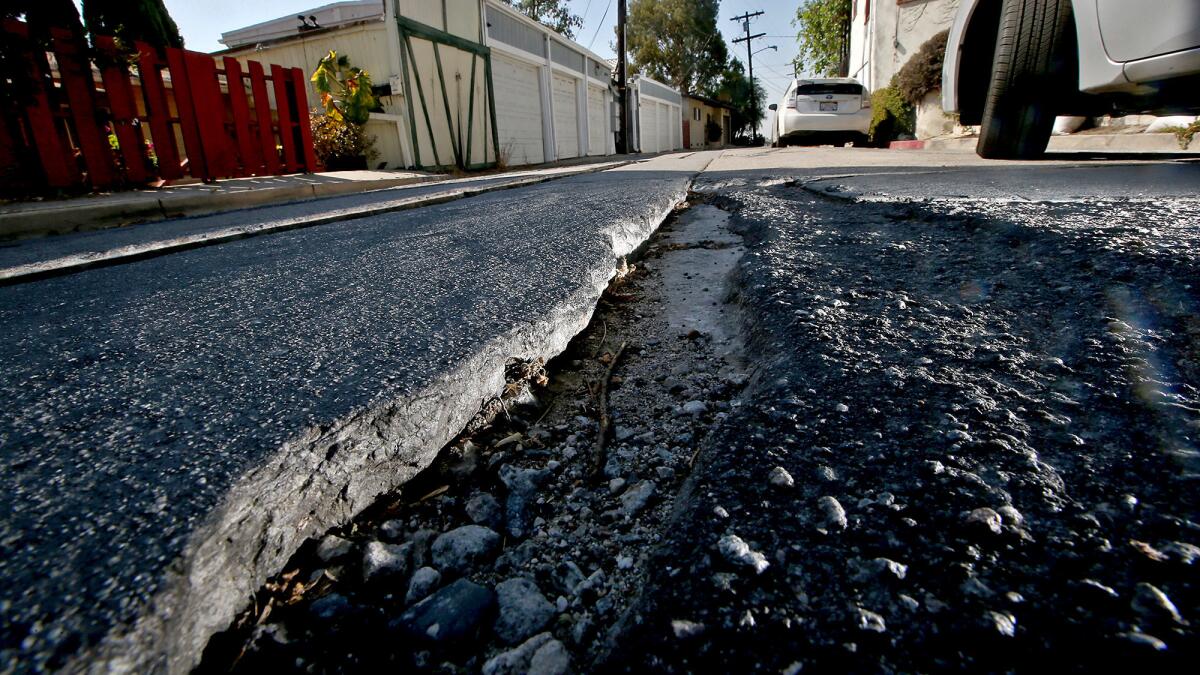Rebuilding crumbling infrastructure has bipartisan support. But who gets to pay for it?

Reporting from Washington — The grades for major U.S. infrastructure would give any parent indigestion if they were on a child’s report card.
Roads: D; bridges: C+; dams: D; ports: C+: railways: B; airports: D; schools: D+; public transit: D-.
The nation’s overall grade: D+, which translates to being “in fair to poor condition and mostly below standards” with “significant deterioration” and a “strong risk of failure,” according to an evaluation last year by the American Society of Civil Engineers.
And it won’t be cheap to fix all that crumbling infrastructure and build badly needed new projects. The estimated cost is as much as $4.6 trillion through 2025 — and depends on Republicans and Democrats in Washington acing a subject they have been failing: bipartisanship.
But the results of the November elections — particularly California voters refusing to repeal an increase in the state’s gas tax to pay for road and bridge repairs — are spurring optimism that a major infrastructure initiative is possible if party leaders can overcome key differences in how it would be structured.
The need to rebuild the nation’s highways, dams and other infrastructure is one of the only areas of agreement among President Trump, congressional Republicans and Democrats, who will take control of the House next year. Projects range from filling dangerous potholes on Interstate 5 in California to the proposed $30-billion Gateway project to upgrade bridge and tunnel connections between New York City and New Jersey.

Leading business groups have made a significant boost in infrastructure spending a top priority, and the projects could provide a lift to the U.S. economy as the stimulus effect of the recent Republican tax cuts starts to fade. That all has experts pointing to infrastructure as the most likely major legislative accomplishment for both parties before the next elections in 2020.
“The conventional wisdom is there’s a lot of reason to work together. Both sides want an infrastructure program,” said Henry Cisneros of Siebert Cisneros Shank & Co., a firm that manages financing for large-scale infrastructure projects.
“But whether it will happen will depend almost exclusively on whether the political climate is contentious preparing for 2020 or both sides see the benefit in getting it done,” said Cisneros, who served as Housing and Urban Development secretary from 1993-97.
The day after the November election, Trump said he and Democrats “have a lot of things in common on infrastructure” and cited it as one of the issues the two parties could work on next year.
Rep. Peter A. DeFazio (D-Ore.), the likely new chairman of the House Transportation and Infrastructure Committee, said a White House official visited him in September to discuss infrastructure investment, apparently with an eye toward a Democratic takeover of the House.
“I’m cautiously optimistic that we can actually get something done,” DeFazio said.
But there are major hurdles to a deal.
Democrats have called for $1 trillion in new federal spending over 10 years. Trump has proposed trying to leverage $200 billion in federal money in partnership with the private sector to produce $1.5 trillion in new infrastructure over the same period.
On top of the huge discrepancy in the amount of federal funding is a debate over how to raise the money. That question has become more pressing since the federal budget deficit soared this year after the big corporate and individual tax cuts took effect.
Trump’s plan, unveiled in January, called for the federal spending to be offset by unspecified budget cuts. Democrats want to raise the federal gas tax, which has not been increased since 1993. Business groups also support a modest hike in the gas tax. Most Republicans and conservative groups have opposed any increase in the 18.4-cent-a-gallon tax.
But Trump told DeFazio and other Democrats in a meeting in February he was open to a 25-cent increase, phased in over five years. The U.S. Chamber of Commerce has proposed such an increase, noting the tax, designed to fund highway and mass transit spending, hasn’t kept up with inflation over the last 25 years.
“A lot of the Congress wants infrastructure, but now we have to figure out a way to pay for it,” said Ed Mortimer, the business group’s vice president of transportation and infrastructure. “From a business community standpoint, we’re willing to stand by these elected officials to get this done.”
There’s little debate that much of the nation’s infrastructure — a broad category that includes public parks, high-speed internet access, pipes for delivering drinking water and facilities holding hazardous waste — is badly in need of significant upgrades.
The aging drawbridges carrying Interstate 5 over the Columbia River between Oregon and Washington are stretched beyond capacity and don’t meet seismic standards, but a multibillion-dollar plan to replace them has stalled for years. The nation’s out-of-date air traffic control system is in the midst of a $36 billion overhaul to replace ground-based radar with satellite tracking, but funding to complete it is in question.
And Amtrak’s Portal Bridge in New Jersey often malfunctions and needs workers to bang the rails back into place with sledgehammers. It is part of the Gateway project that is seeking federal funding. One New Jersey commuter even set up a GoFundMe campaign recently to draw attention to the problem.
Last year, California officials drew up a wish list of $100 billion in state projects for possible additional federal funding. They included the replacement Gerald Desmond Bridge under construction in Long Beach, an expansion of the Los Angeles-to-San Francisco bullet train project to include service to San Jose and an earthquake early warning system.
“I think there is a need to both renew — by that I mean repair deterioration and bring things up to good operating condition — and there’s a need to modernize,” said Martin Wachs, a retired professor of urban planning at the UCLA Luskin School of Public Affairs.
The American Society of Civil Engineers’ evaluation found about 9% of the nation’s bridges — 56,007 of them — were structurally deficient in 2016.
Highways are in even worse shape, with drivers spending about a fifth of their time on rough pavement. And about 31% of public transit tracks, tunnels and other fixed guideways were in poor condition in 2012, according to the latest data from the U.S. Transportation Department.
Nearly a third of schools — 31% — use trailers or other temporary buildings. The average dam is 56 years old and many are not expected to survive major floods or earthquakes, with about 17%, or 15,500, having the potential to cause loss of life if they failed, the engineers group said.

In some ways, car-dependent Californians have it the worst.
Aside from hours-long commutes, they drive on some of the roughest pavement in the country, with San Francisco, San Jose and Los Angeles topping the list of major urban areas with the highest percentage of bad roads, according to TRIP, a nonprofit research group sponsored by insurers, equipment manufacturers, labor unions and others that would benefit from increased spending.
Well over half the major roads in those cities were in poor condition, and the ragged condition of the state’s transportation infrastructure was the motivation behind legislation last year to increase the gas tax and vehicle fees to provide $5.2 billion a year to do repairs and other construction.
It raised the state gas tax by 12 cents a gallon and created a new annual vehicle fee ranging from $25 to $175 depending on a car’s value. Starting in 2020, electric car owners also will pay a $100 annual fee in lieu of gas taxes.
Top Republicans opposed the law and put a repeal initiative on the November ballot. While they raised $5 million, supporters of the gas tax, including the construction industry and labor unions, raised $47 million to defeat it. The repeal failed, receiving only 43.3% of the vote.
“People will vote for higher taxes if they believe it will be used for a good purpose that they believe is necessary,” said Rep. John Garamendi (D-Walnut Grove), who serves on the House transportation committee.
The strong support among California voters for a gas tax wasn’t the only positive sign about infrastructure support in the November election. In Minnesota, Democrat Tim Walz won the governor’s race after calling for a gas tax increase to pay for infrastructure improvements. And Democrat Gretchen Whitmer, who was elected Michigan’s governor, campaigned on a “fix the damn roads” slogan.
Polls show Americans aren’t happy with state and federal infrastructure efforts and support increased spending.
About 62% said the federal government is not spending enough on transportation infrastructure projects in their area, according to a May survey by Monmouth University.
But there’s no consensus on how to pay for it, with the public roughly equally split on raising the federal gas tax, according to a Quinnipiac University poll in February.
The federal gas tax is the primary source of revenue for the highway trust fund. The fund pays for federal transportation programs and grants for state and local projects. But inflation has eroded the value of the revenue generated over the last 25 years even as infrastructure costs have risen.
The highway fund hasn’t been able to pay for all authorized projects, forcing Congress to fill the gap with $144 billion in additional money through 2020. After that, unless Congress ponies up more money, the fund will start running an annual shortfall again that will grow to $161 billion by 2028, according to the Congressional Budget Office.
It’s part of an overall funding gap for infrastructure. From 2016-2025, estimated funding is projected to fall nearly $2.1 trillion short of the $4.6 trillion needed, according to the American Society of Civil Engineers, a group whose members also would benefit from increased infrastructure spending.
So a gas tax increase to boost funding makes sense to many politicians and business groups such as the U.S. Chamber of Commerce, the Business Roundtable and the National Assn. of Manufacturers.
The survival of California’s gas tax is fueling optimism that a modest federal gas tax increase could happen.
“We were heartened by the California vote,” Mortimer of the U.S. Chamber said. “It would have been a big challenge to get revenue adjustments in Washington if the California vote went the other way.”
Trump’s proposal this year did not include a gas tax increase, instead relying on public-private partnerships that have a checkered history. Trump’s plan is similar to the United Kingdom’s Private Finance Initiative, recently ended by British lawmakers as there was broad agreement the partnerships drove up costs because the government can borrow money more cheaply than private firms.
DeFazio said public-private partnerships can play a limited role. But significantly improving U.S. infrastructure will require “real money” and increasing the gas tax makes the most sense, he said.
Trump’s backing would be key, DeFazio said. “If the president supports it … I think a lot of Republicans would come along,” he said.
A White House spokeswoman declined a request for comment.
There is strong conservative opposition to a gas tax increase. A coalition of conservative and free-market groups — which claim existing funds are being frittered away on pet projects and red tape — sent a letter to members of Congress this year declaring, “Raising the gas tax is a bad idea.”
Senate Majority Leader Mitch McConnell (R-Ky.) said after the November election that he hoped Congress could pass infrastructure legislation, but he was not interested in increasing the federal budget deficit to do it.
The deficit is projected to jump $1.5 trillion by 2028 because of the tax cuts Republicans pushed through Congress last year. In the 2018 fiscal year, which ended Sept. 30, the budget deficit increased 17% to $779 billion from a year earlier.
Some Democrats have suggested scaling back the corporate tax cuts to help pay for infrastructure. But congressional aides have said it’s a non-starter and business groups would oppose it.
McConnell acknowledged that “almost everybody seems to be interested” in pursuing major infrastructure legislation next year.
“You know what the sticking point is?” he told reporters. “How do you pay for it?”
Twitter: @JimPuzzanghera
More to Read
Inside the business of entertainment
The Wide Shot brings you news, analysis and insights on everything from streaming wars to production — and what it all means for the future.
You may occasionally receive promotional content from the Los Angeles Times.











